2012中考一轮复习精品课件(含2011中考真题)英语外研版七上Modules1-5(51张ppt)
文档属性
| 名称 | 2012中考一轮复习精品课件(含2011中考真题)英语外研版七上Modules1-5(51张ppt) |  | |
| 格式 | rar | ||
| 文件大小 | 389.7KB | ||
| 资源类型 | 教案 | ||
| 版本资源 | 通用版 | ||
| 科目 | 英语 | ||
| 更新时间 | 2012-01-12 10:41:39 | ||
图片预览

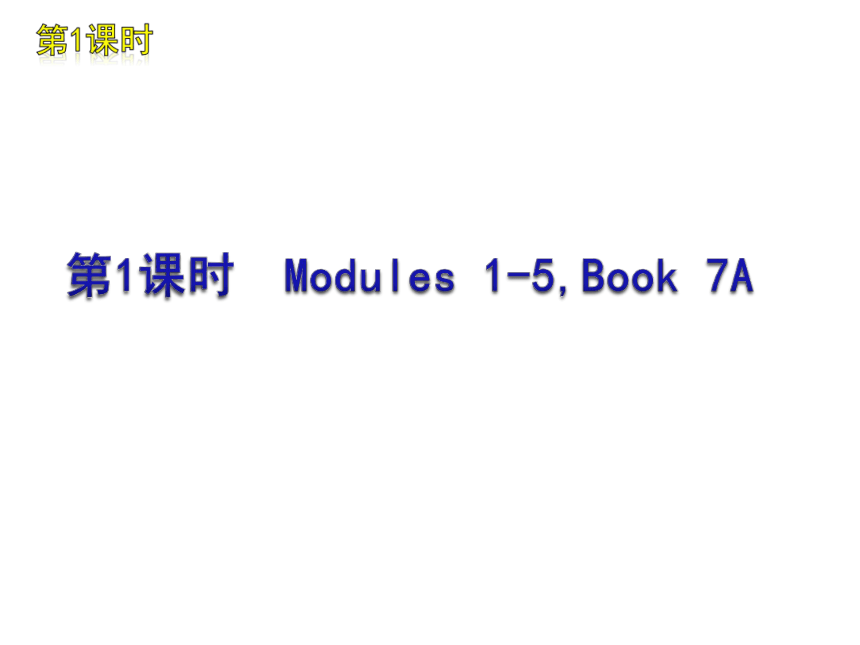
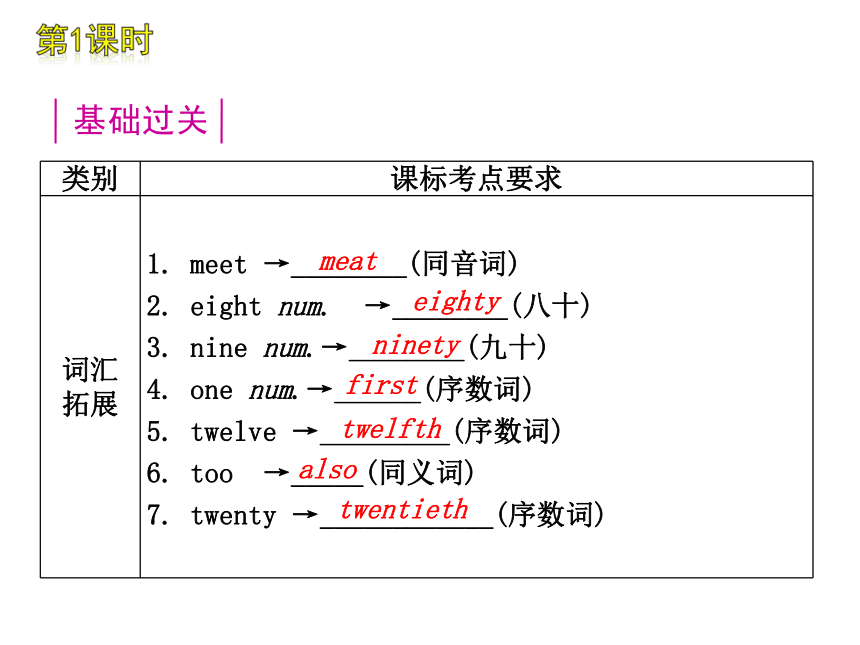
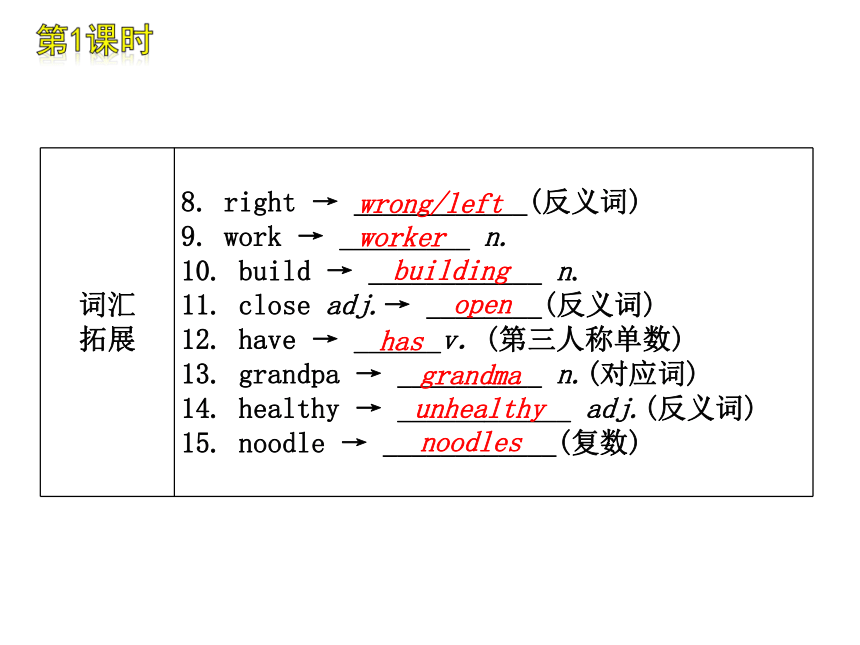
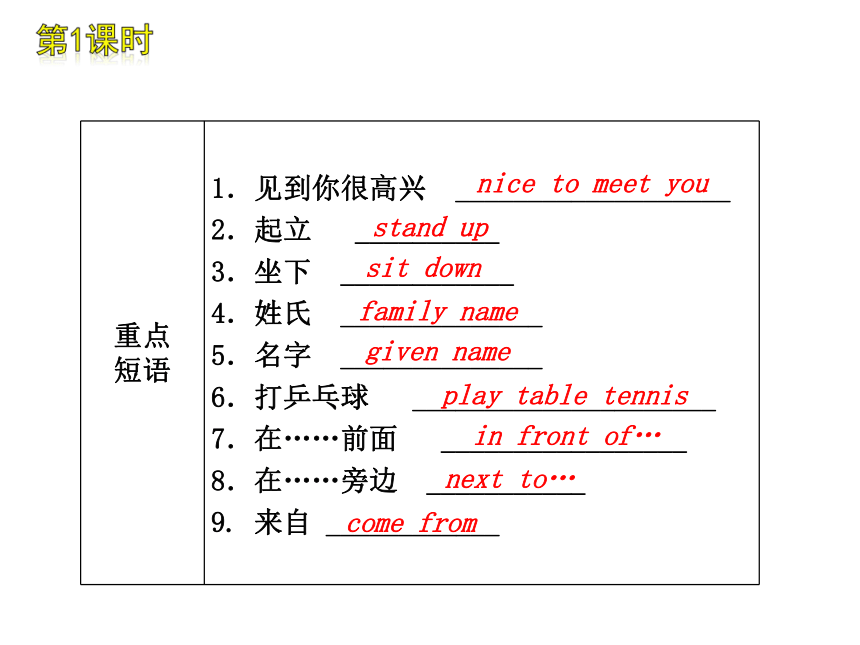
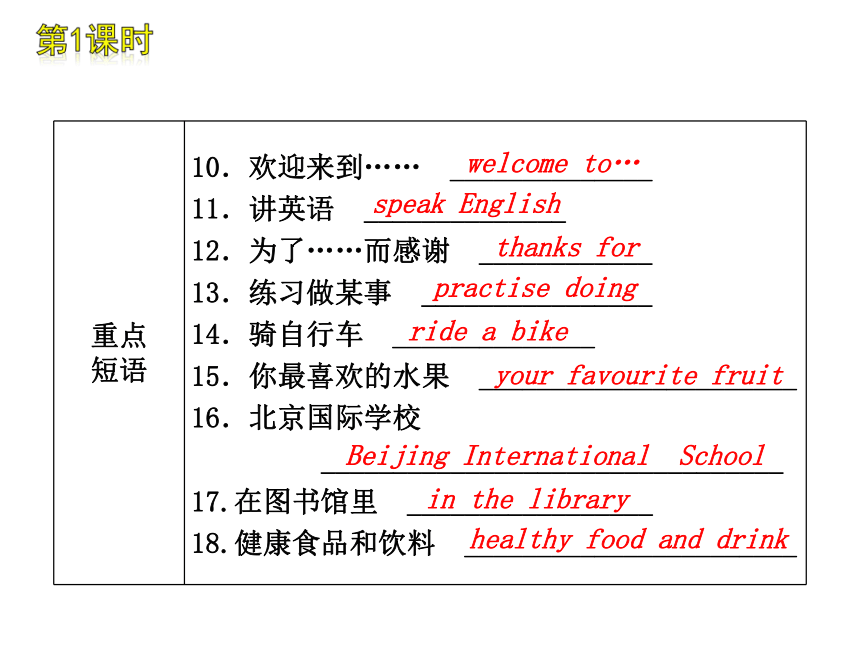
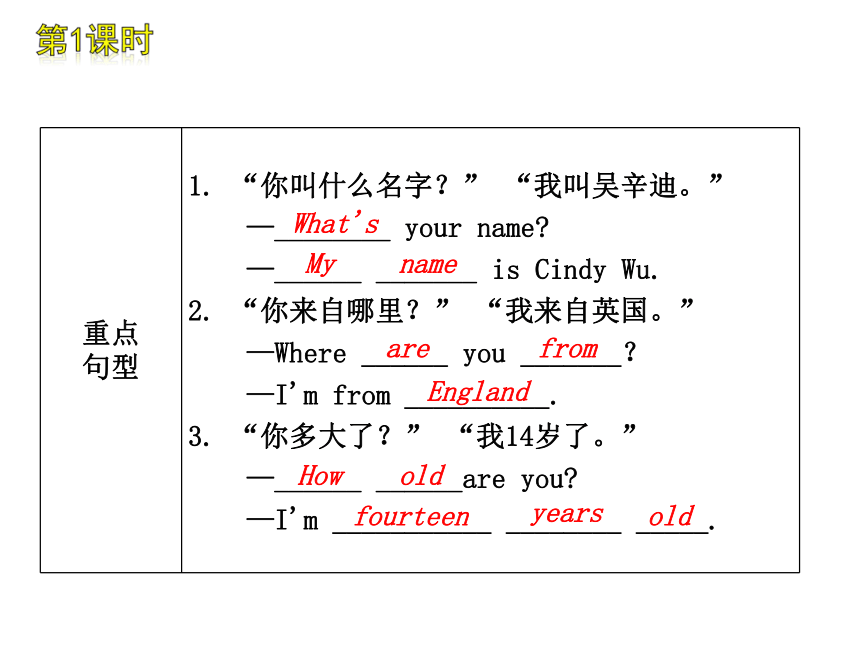
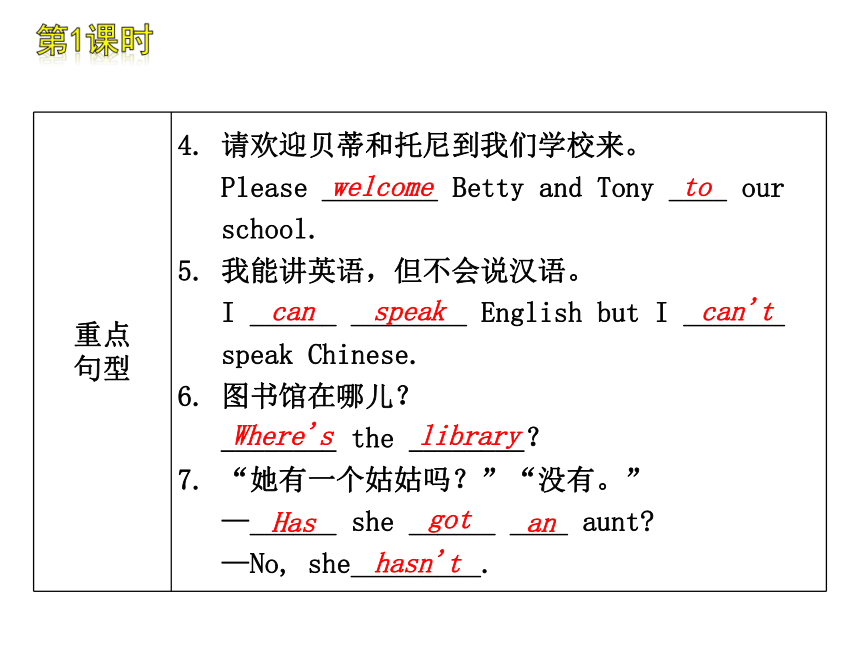
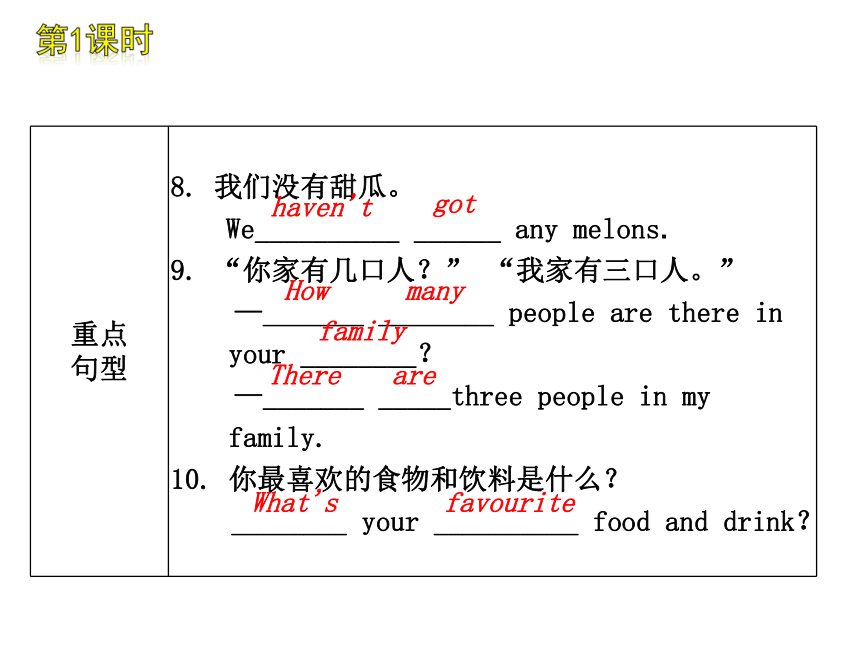
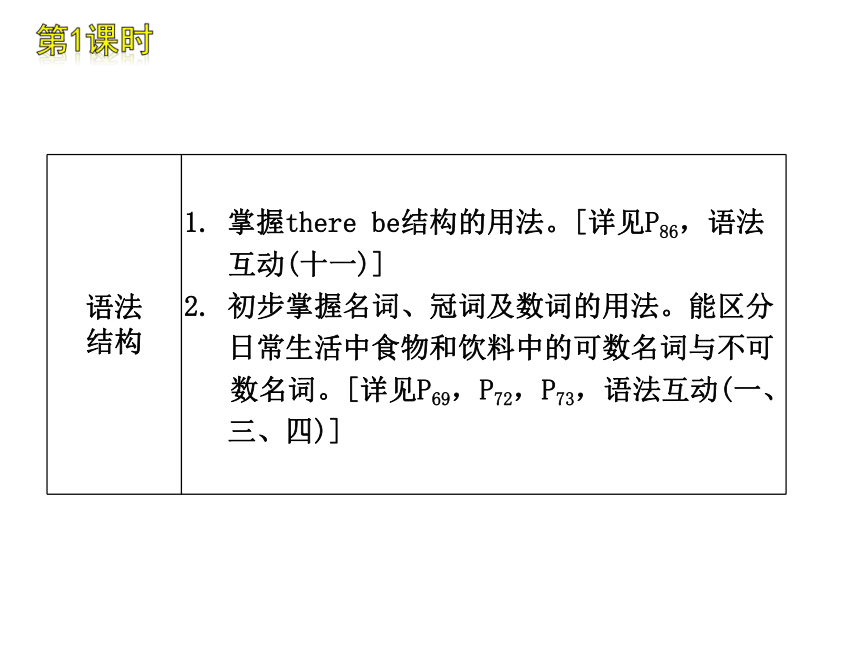
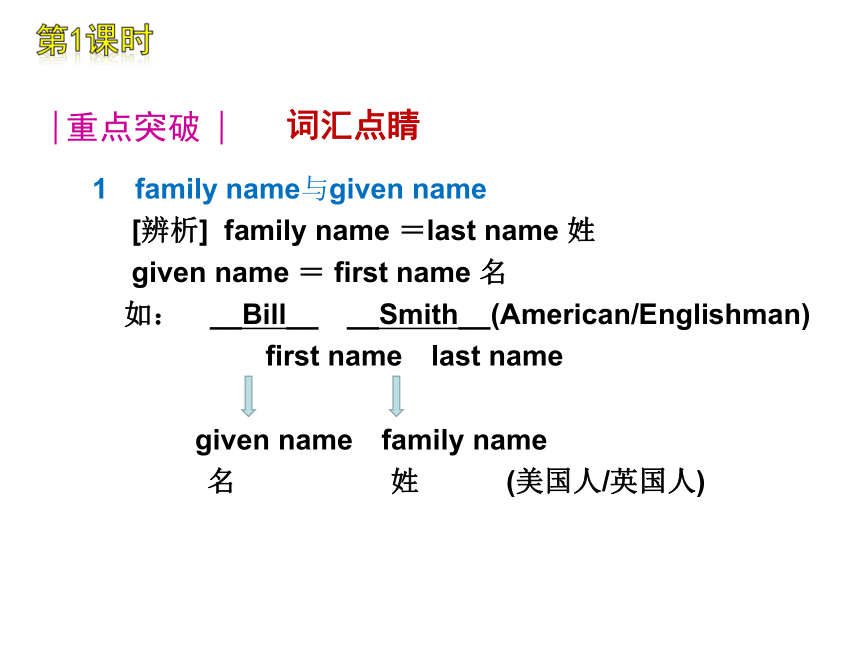
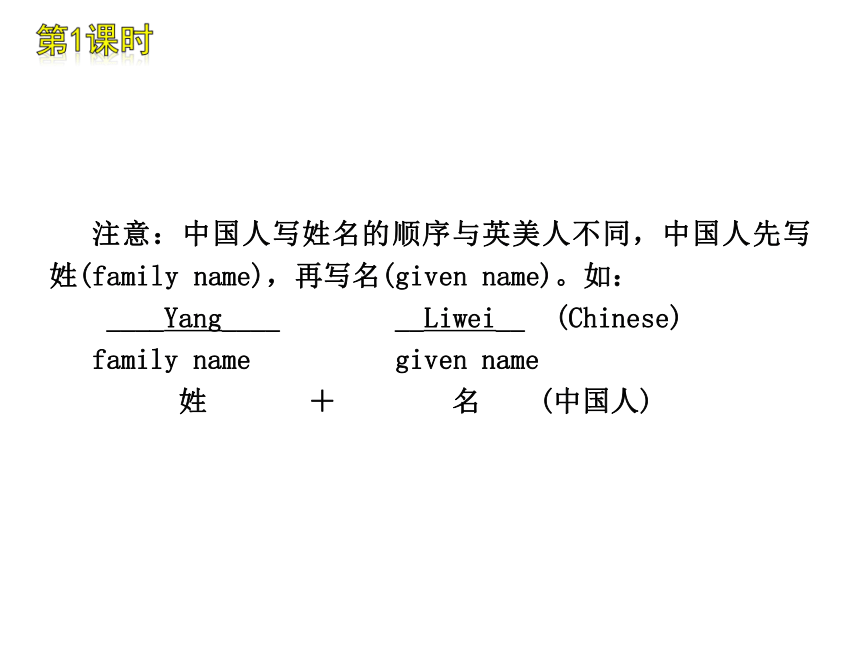
文档简介
(共51张PPT)
2012版中考一轮复习精品课件
外研版
含2011中考真题
·外研版(衔接)
基础过关
·外研版(衔接)
类别 课标考点要求
词汇
拓展 1. meet →________(同音词)
2. eight num. →________(八十)
3. nine num.→________(九十)
4. one num.→______(序数词)
5. twelve →_________(序数词)
6. too →_____(同义词)
7. twenty →____________(序数词)
meat
eighty
ninety
first
twelfth
also
twentieth
·外研版(衔接)
词汇
拓展 8. right → ____________(反义词)
9. work → _________ n.
10. build → ____________ n.
11. close adj.→ ________(反义词)
12. have → ______v.(第三人称单数)
13. grandpa → __________ n.(对应词)
14. healthy → ____________ adj.(反义词)
15. noodle → ____________(复数)
wrong/left
worker
building
open
has
grandma
unhealthy
noodles
·外研版(衔接)
重点
短语 1.见到你很高兴 ___________________
2.起立 __________
3.坐下 ____________
4.姓氏 ______________
5.名字 ______________
6.打乒乓球 _____________________
7.在……前面 _________________
8.在……旁边 ___________
9. 来自 ____________
nice to meet you
stand up
sit down
family name
given name
play table tennis
in front of…
next to…
come from
·外研版(衔接)
重点
短语 10.欢迎来到…… ______________
11.讲英语 ______________
12.为了……而感谢 ____________
13.练习做某事 ________________
14.骑自行车 ______________
15.你最喜欢的水果 ______________________
16.北京国际学校
________________________________
17.在图书馆里 _________________
18.健康食品和饮料 _______________________
welcome to…
speak English
thanks for
practise doing
ride a bike
your favourite fruit
Beijing International School
in the library
healthy food and drink
·外研版(衔接)
重点
句型
1. “你叫什么名字?” “我叫吴辛迪。”
—________ your name
—______ _______ is Cindy Wu.
2. “你来自哪里?” “我来自英国。”
—Where ______ you _______?
—I'm from __________.
3. “你多大了?” “我14岁了。”
—______ ______are you
—I'm ___________ ________ _____.
What's
My
name
are
from
England
How
old
fourteen
years
old
·外研版(衔接)
重点
句型 4. 请欢迎贝蒂和托尼到我们学校来。
Please ________ Betty and Tony ____ our
school.
5. 我能讲英语,但不会说汉语。
I ______ ________ English but I _______
speak Chinese.
6. 图书馆在哪儿?
________ the ________?
7. “她有一个姑姑吗?”“没有。”
—______ she ______ ____ aunt
—No, she_________.
welcome
to
can
speak
can't
Where's
library
Has
got
an
hasn't
·外研版(衔接)
重点
句型 8. 我们没有甜瓜。
We__________ ______ any melons.
9. “你家有几口人?” “我家有三口人。”
—_______ ________ people are there in
your ________?
—_______ _____three people in my
family.
10. 你最喜欢的食物和饮料是什么?
________ your __________ food and drink?
haven't
got
How
many
family
There
are
What's
favourite
·外研版(衔接)
语法
结构 掌握there be结构的用法。[详见P86,语法
互动(十一)]
2. 初步掌握名词、冠词及数词的用法。能区分
日常生活中食物和饮料中的可数名词与不可
数名词。[详见P69,P72,P73,语法互动(一、
三、四)]
·外研版(衔接)
词汇点睛
重点突破
family name与given name
[辨析] family name =last name 姓
given name = first name 名
如: __Bill__ __Smith__(American/Englishman)
first name last name
given name family name
名 姓 (美国人/英国人)
·外研版(衔接)
注意:中国人写姓名的顺序与英美人不同,中国人先写姓(family name),再写名(given name)。如:
____Yang____ __Liwei__ (Chinese)
family name given name
姓 + 名 (中国人)
·外研版(衔接)
活学活用
他的名字叫比尔·史密斯,所以我们可以叫他比尔或史密
斯先生。
_____ _______is Bill Smith. So we can _____ him
_______ or Mr ________.
(2)我叫玛丽·格林,玛丽是我的名,格林是姓。
My name is ______ _______. Mary is my _____________
________; Green is my ____________ ______.
His
name
call
Bill
Smith
Mary
Green
given
name
/first
family
name
/last
·外研版(衔接)
2 thank sb. for… 因……而感谢某人
Thank you for understanding me so much.
感谢您这么理解我。
[拓展] thanks n.感激,感谢
thanks to 由于,幸亏
Thanks to my teachers' help, I passed the
exam finally.
多亏老师的帮助,我终于通过了这次考试。
·外研版(衔接)
活学活用
根据中英文提示完成句子
(1) Thanks for ________ (help)me with my study.
(2) ________ ____ (多亏) the Green Great
Wall, many crops have been protected.
helping
Thanks
to
·外研版(衔接)
3 first
[点拨] (1) num. 第一
常和定冠词the 连用,后常接单数可数名词,也可接
复数名词。如:
the first lesson 第一课
the first visitors 第一批客人
(2) adj. & adv. 初次,最初
常用短语:at first 起初
first of all 首先
from first to last 自始至终
·外研版(衔接)
活学活用
用括号内所给词的适当形式填空
At ________ (one), Candy got to school early,
but she is often late for class now.
(2)Tom is _______(one) year old, and his family
is going to celebrate his ________ birthday.
first
one
first
·外研版(衔接)
4 close vt.关闭(同shut),反义词open
Would you mind closing the door for me?We
are having a meeting.
你介意帮我关上门吗?我们正在开会。
[拓展] (1) closed adj.关闭的,停业的。反义
词open“开业的”。如:
The shop is open at eight o'clock in the
morning and closed at six in the evening.
这家商店在早上8:00营业,晚上6:00关门。
·外研版(衔接)
(2) close adj.& adv. 亲密的,近;靠近
常用短语:
be close to sp. 离某地近
be close to sb. 和某人相处亲密
live close to sp. 住的地方离某地近
·外研版(衔接)
活学活用
(1) Betty和她的英语老师关系很亲密。
Betty ____________ her English teacher.
(2) 我们的学校离我家很近。
Our school _______________ my house.
(3) 时间很晚了,这家商店关门了。
It's dark.The shop ___________ now.
is close to
is close to
is closed
·外研版(衔接)
5 too adv.也
[点拨] too是个常用词,多用于口语。一般用在
肯定句中,放在句末,或作为插入语放在句中。如:
I'm in Class 1,too.我也在一班。
She,too,is a singer.她也是一位歌唱家。
[辨析] also, either, as well和too
这四个词(组)互为同义词,但用法不同。
(1) also 是比较正式的用语。它经常放在句中,位
于行为动词之前,系动词、助动词或情态动词之后。如:
·外研版(衔接)
(2)either表示“也”时一般只用于否定句,且只置于
句末。如:
If you don't go there,he won't go there,either.
如果你不去那儿,他也不去那儿。
(3)as well常用于口语,用法和too一样,通常位于句
末,但前面通常不用逗号。如:
She is a teacher and a singer as well.
她是教师,也是歌唱家。
·外研版(衔接)
活学活用
同义句转换
(1) They also come and help.
They come ________ help,________.
(2) She is not hungry and neither am I.
She is not hungry and I am not hungry,
________.
and
too
either
·外研版(衔接)
6 practise v.练习;实践
[搭配] practise doing sth. 练习干某事 如:
My mother often practises cooking the fish.
我妈妈常练习做鱼。
·外研版(衔接)
活学活用
( )[2010·达州] Why not ______ an English
club to practise ______ English
A. to join; to speak
B. join; speaking
C. join; to speak
D. to join; speaking
B
·外研版(衔接)
7 family n.家庭
[点拨] 做“家庭”讲时被看作整体,为单数概念;做“家庭成员”讲时,表示复数概念。如:
My family is a happy one.(整体)
我家是幸福的一家。
Her family are all waiting for her outside.(成员)
她的家人们都在外面等她。
[拓展] 类似用法的单词有:class班级,group组,team队,population人口等。
·外研版(衔接)
活学活用
( ) My family ________moved to New York;
all my family ______working there
happily.
A. have; are B. have; is
C. has; are D. has; is
C
·外研版(衔接)
8 welcome vt.& n.欢迎
[搭配] welcome back欢迎回来
welcome to+ 地点名词
welcome+地点副词(如home, here, there, abroad, upstairs, downstairs)
give a warm welcome to sb.= warmly welcome sb.如:
Welcome home,kids!孩子们,欢迎回家!
Welcome to China!欢迎来到中国!
Let's give a warm welcome to Premier Wen Jiabao.
让我们热烈欢迎温家宝总理。
·外研版(衔接)
活学活用
( ) A lot of students were standing on
both sides of the main street, giving
a warm _____ to President Obama from
America.
A. hand B. welcome
C. welcoming D. to welcome
B
·外研版(衔接)
9 some与any
[辨析] (1) some意思是“一些;有一些”,常用于肯定句中作主语、宾语或定语。作定语时,它可以修饰可数名词,也可以修饰不可数名词。如:
He wants some water.
他想要一些水。
Some students are playing soccer.
有些学生正在踢足球。
·外研版(衔接)
(2) any 意思是“一些;有一些”,常用于否定句和疑问句中。作定语时,它可以修饰所有的名词。如:
Do you have any paper 你有一些纸吗?
此外,any也可以用于肯定句,这时它的意思是“任何”,而不是“一些”。如:
Any student can answer this question.
任何学生都可以回答这个问题。
[提醒] some还可用于表示请求建议的疑问句中,表示希望得到对方的肯定回答。如:
Can I have some meat, Mum 妈妈,我可以吃些肉吗?
·外研版(衔接)
活学活用
(1) —Would you like ________ more coffee
—Yes, please.
(2) —Can you believe we've run out of milk!
—Would you like me to get ________ at
the nearest shop
(3) If you have ________ trouble,let me know it.
some
some
any
·外研版(衔接)
10 make v.制作; 做
[点拨] 此时make后可跟双宾语,间接宾语后移时,介词用for。
make sb. sth. = make sth. for sb.为……制作……
如:
My uncle will make me a kite.=My uncle will make a kite for me.
我叔叔将为我做一个风筝。
·外研版(衔接)
[搭配] make friends with sb.和某人交朋友
be made of 用某种原材料制成(可以看出原材料)
be made from 用某种原材料制成(看不出原材料)
make a mistake 犯错误
make a decision 作出决定
make noise 制造噪音
make a face 做鬼脸
make money 挣钱
make progress 取得进步
make use of 利用
·外研版(衔接)
活学活用
1. 用make词组填空
Our desks and chairs ______ _______ _____
wood.
(2) Tony often ________ ________ in class. Our teacher is angry with him.
(3) We always ______ the birthday cake ______
Tony.
2. 根据汉语提示完成句子
Lingling sometimes ______ ______ ________
________(交外国朋友)in English pubs.
are
made
of
makes
faces
make
for
makes
some
foreign
friends
·外研版(衔接)
句型透视
1 This is Daming. 这是大明。
[点拨] (1)向第三者介绍旁边的熟人时,常用This
is… 向第三者介绍远处的熟人时,常用That is…
(2)其复数形式分别是These are… Those are… 如:
These are my parents. 这是我的父母。
(3)打电话时进行自我介绍用This is…,而不是I'm…;
that常用于询问并指代对方,Who is that
Isthat…speaking 如:
—Hello, is that Tom 喂,你是汤姆吗?
—Yes, this is Tom. 是的,我是。
·外研版(衔接)
活学活用
( )—Who's that speaking
—________.
A. I'm Wang Hui
B. That's Wang Hui speaking
C. It's me
D. This is Wang Hui
D
本题考查打电话的常用语。由Who’s that speaking 可
知, 应答语是This is …
·外研版(衔接)
2 There are 46 students in my class.
我们班有46名学生。
[点拨] (1) there be 句型的基本结构:There be +
某物/某人 + 某地,表示“某地有某人或某物”。be
动词的单、复数根据其后的主语来选取,即遵循“就近
原则”;各种时态的变化也是通过be动词的变化来体现
的。如:
There is a computer and two notebooks on my desk.
在我书桌上有一台电脑和两个笔记本。
There weren't any schools here in the past.
过去这儿没有任何学校。
·外研版(衔接)
(2) 该句型中的there 不是地点副词“那里”,而是引导词,该句实则是一个倒装句。
[辨析] there be 与have/ has got
(1)there be 强调某处存在某物,而have/has got则强调所属关系,指“某人(某物)拥有什么”。 如:
There are some oranges on the table.
桌子上有一些桔子。
My father has got a new car.
我爸爸有一辆新的小汽车。
·外研版(衔接)
(2)当两者表示整体与局部关系时,there be 结构与have/ has got可以互换。
There are seven days in a week.= A week has got seven days. 一周有七天。
活学活用
( ) (1)There ________ some milk, two eggs and
a few cakes on the table.
A. is B. are C. has D. have
A
there be 句型谓语动词的单复数遵循就近原则。
·外研版(衔接)
( ) (2) There ______ a strong wind tonight.
A. will have B. is going to have
C. have been D. will be
D
由题意可知用一般将来时, 通过be动词的变化来体现。
·外研版(衔接)
Fruit and vegetables are healthy food but
hamburgers and candy aren't healthy food.
水果和蔬菜都是健康食品,但是汉堡和糖都不是健康食
品。
[点拨] and 和but 都是连词,and 为并列连词, but为转折连词。如:
I like playing the piano and speaking English.
我喜欢弹钢琴和说英语。
·外研版(衔接)
[拓展] (1)or可作并列连词,用在否定句或疑问句中,代替and。如:
Is your friend a boy or a girl
你的朋友是个男孩还是女孩?
(2)or也可作“要不然;否则”讲。如:
Go at once, or you will miss the train.
马上去,否则你会赶不上火车。
·外研版(衔接)
活学活用
( ) (1)Lots of people go to work by bus, _____
I go to work by bike.
A. and B. so C. or D. but
( ) (2)Hurry up, _____ you are not able to catch
the last bus.
A. so B. but C. and D. or
D
D
·外研版(衔接)
高频考点
( ) 1. —I need something for cutting the paper.
—Oh,you want a knife OK,I'll get
________ for you.
A. it B. that C. this D. one
D
本题考查代词的用法。空格处表示泛指, 故用one代替与前面事物同属一类的事物。
【2011 山东青岛】
17. Harry Potter is so interesting a book that lots of teenagers like to read _
A. it B. this C. that D. one
答案:A 【解析】考查代词的用法。由句意可知Harry Potte这本书很有趣,以至于很多年轻人都喜欢读“它”。空缺处是再次提及这本书,故答案选A。it=the+名词单数,特指。
·外研版(衔接)
( ) 2. [2010·三亚]—Will you stay here for
supper
—Sorry,I ________.I'll have to meet my
uncle at the station.
A. mustn't B. can't
C. needn't D. don't
B
句意为:“你将在这儿吃晚饭吗?”“很遗憾, 我不能。我将去车站接我叔叔。” mustn't 禁止; can't 不能; needn't 不需要; don't助动词, 不能回答will引导的一般疑问句。除can't 外, 均不符合题意。
·外研版(衔接)
( ) 3. —______?
—He is a policeman.
A. What does your father do
B. How old is your father
C. How many people are there in the room
D. Where is your father
A
由回答可知, 问句应提问职业, 只有A符合题意。
How old 是用来提问年龄的; How many用来询问数
量多少;where是用来询问地点的。
·外研版(衔接)
( ) 4. I like _____ a lot,and my mother usually
cooks it in different ways.
A. fish B. butter
C. potatoes D. noodles
A
名词单复数形式是近几年中考考查的重点。由句中
it可知, 应选择单数或不可数名词, 所以排除C,
D两个答案; 由句意“用不同的方法做它”, 判断
答案应是A。
【2011四川宜宾】
23. There are many _______ playing on the playground.
A. child B. children C. man teachers D. sheeps
答案:B
【解析】B 考查名词复数用法 孩子的复数是“children”,男老师“men teachers”, 羊“sheep”单复数相同。故选B。
【2011 四川广元】
10.Our hospital needs two ___ doctors, Mrs Li. You can ask your son to have a try.
A. women B. man C. men
答案:C 【解析】名词复数。由“你让你的儿子试一试”可知“我们医院需要两名男医生”,排除A;man作doctors的定语,doctors用复数,故man也应用复数形式。
2012版中考一轮复习精品课件
外研版
含2011中考真题
·外研版(衔接)
基础过关
·外研版(衔接)
类别 课标考点要求
词汇
拓展 1. meet →________(同音词)
2. eight num. →________(八十)
3. nine num.→________(九十)
4. one num.→______(序数词)
5. twelve →_________(序数词)
6. too →_____(同义词)
7. twenty →____________(序数词)
meat
eighty
ninety
first
twelfth
also
twentieth
·外研版(衔接)
词汇
拓展 8. right → ____________(反义词)
9. work → _________ n.
10. build → ____________ n.
11. close adj.→ ________(反义词)
12. have → ______v.(第三人称单数)
13. grandpa → __________ n.(对应词)
14. healthy → ____________ adj.(反义词)
15. noodle → ____________(复数)
wrong/left
worker
building
open
has
grandma
unhealthy
noodles
·外研版(衔接)
重点
短语 1.见到你很高兴 ___________________
2.起立 __________
3.坐下 ____________
4.姓氏 ______________
5.名字 ______________
6.打乒乓球 _____________________
7.在……前面 _________________
8.在……旁边 ___________
9. 来自 ____________
nice to meet you
stand up
sit down
family name
given name
play table tennis
in front of…
next to…
come from
·外研版(衔接)
重点
短语 10.欢迎来到…… ______________
11.讲英语 ______________
12.为了……而感谢 ____________
13.练习做某事 ________________
14.骑自行车 ______________
15.你最喜欢的水果 ______________________
16.北京国际学校
________________________________
17.在图书馆里 _________________
18.健康食品和饮料 _______________________
welcome to…
speak English
thanks for
practise doing
ride a bike
your favourite fruit
Beijing International School
in the library
healthy food and drink
·外研版(衔接)
重点
句型
1. “你叫什么名字?” “我叫吴辛迪。”
—________ your name
—______ _______ is Cindy Wu.
2. “你来自哪里?” “我来自英国。”
—Where ______ you _______?
—I'm from __________.
3. “你多大了?” “我14岁了。”
—______ ______are you
—I'm ___________ ________ _____.
What's
My
name
are
from
England
How
old
fourteen
years
old
·外研版(衔接)
重点
句型 4. 请欢迎贝蒂和托尼到我们学校来。
Please ________ Betty and Tony ____ our
school.
5. 我能讲英语,但不会说汉语。
I ______ ________ English but I _______
speak Chinese.
6. 图书馆在哪儿?
________ the ________?
7. “她有一个姑姑吗?”“没有。”
—______ she ______ ____ aunt
—No, she_________.
welcome
to
can
speak
can't
Where's
library
Has
got
an
hasn't
·外研版(衔接)
重点
句型 8. 我们没有甜瓜。
We__________ ______ any melons.
9. “你家有几口人?” “我家有三口人。”
—_______ ________ people are there in
your ________?
—_______ _____three people in my
family.
10. 你最喜欢的食物和饮料是什么?
________ your __________ food and drink?
haven't
got
How
many
family
There
are
What's
favourite
·外研版(衔接)
语法
结构 掌握there be结构的用法。[详见P86,语法
互动(十一)]
2. 初步掌握名词、冠词及数词的用法。能区分
日常生活中食物和饮料中的可数名词与不可
数名词。[详见P69,P72,P73,语法互动(一、
三、四)]
·外研版(衔接)
词汇点睛
重点突破
family name与given name
[辨析] family name =last name 姓
given name = first name 名
如: __Bill__ __Smith__(American/Englishman)
first name last name
given name family name
名 姓 (美国人/英国人)
·外研版(衔接)
注意:中国人写姓名的顺序与英美人不同,中国人先写姓(family name),再写名(given name)。如:
____Yang____ __Liwei__ (Chinese)
family name given name
姓 + 名 (中国人)
·外研版(衔接)
活学活用
他的名字叫比尔·史密斯,所以我们可以叫他比尔或史密
斯先生。
_____ _______is Bill Smith. So we can _____ him
_______ or Mr ________.
(2)我叫玛丽·格林,玛丽是我的名,格林是姓。
My name is ______ _______. Mary is my _____________
________; Green is my ____________ ______.
His
name
call
Bill
Smith
Mary
Green
given
name
/first
family
name
/last
·外研版(衔接)
2 thank sb. for… 因……而感谢某人
Thank you for understanding me so much.
感谢您这么理解我。
[拓展] thanks n.感激,感谢
thanks to 由于,幸亏
Thanks to my teachers' help, I passed the
exam finally.
多亏老师的帮助,我终于通过了这次考试。
·外研版(衔接)
活学活用
根据中英文提示完成句子
(1) Thanks for ________ (help)me with my study.
(2) ________ ____ (多亏) the Green Great
Wall, many crops have been protected.
helping
Thanks
to
·外研版(衔接)
3 first
[点拨] (1) num. 第一
常和定冠词the 连用,后常接单数可数名词,也可接
复数名词。如:
the first lesson 第一课
the first visitors 第一批客人
(2) adj. & adv. 初次,最初
常用短语:at first 起初
first of all 首先
from first to last 自始至终
·外研版(衔接)
活学活用
用括号内所给词的适当形式填空
At ________ (one), Candy got to school early,
but she is often late for class now.
(2)Tom is _______(one) year old, and his family
is going to celebrate his ________ birthday.
first
one
first
·外研版(衔接)
4 close vt.关闭(同shut),反义词open
Would you mind closing the door for me?We
are having a meeting.
你介意帮我关上门吗?我们正在开会。
[拓展] (1) closed adj.关闭的,停业的。反义
词open“开业的”。如:
The shop is open at eight o'clock in the
morning and closed at six in the evening.
这家商店在早上8:00营业,晚上6:00关门。
·外研版(衔接)
(2) close adj.& adv. 亲密的,近;靠近
常用短语:
be close to sp. 离某地近
be close to sb. 和某人相处亲密
live close to sp. 住的地方离某地近
·外研版(衔接)
活学活用
(1) Betty和她的英语老师关系很亲密。
Betty ____________ her English teacher.
(2) 我们的学校离我家很近。
Our school _______________ my house.
(3) 时间很晚了,这家商店关门了。
It's dark.The shop ___________ now.
is close to
is close to
is closed
·外研版(衔接)
5 too adv.也
[点拨] too是个常用词,多用于口语。一般用在
肯定句中,放在句末,或作为插入语放在句中。如:
I'm in Class 1,too.我也在一班。
She,too,is a singer.她也是一位歌唱家。
[辨析] also, either, as well和too
这四个词(组)互为同义词,但用法不同。
(1) also 是比较正式的用语。它经常放在句中,位
于行为动词之前,系动词、助动词或情态动词之后。如:
·外研版(衔接)
(2)either表示“也”时一般只用于否定句,且只置于
句末。如:
If you don't go there,he won't go there,either.
如果你不去那儿,他也不去那儿。
(3)as well常用于口语,用法和too一样,通常位于句
末,但前面通常不用逗号。如:
She is a teacher and a singer as well.
她是教师,也是歌唱家。
·外研版(衔接)
活学活用
同义句转换
(1) They also come and help.
They come ________ help,________.
(2) She is not hungry and neither am I.
She is not hungry and I am not hungry,
________.
and
too
either
·外研版(衔接)
6 practise v.练习;实践
[搭配] practise doing sth. 练习干某事 如:
My mother often practises cooking the fish.
我妈妈常练习做鱼。
·外研版(衔接)
活学活用
( )[2010·达州] Why not ______ an English
club to practise ______ English
A. to join; to speak
B. join; speaking
C. join; to speak
D. to join; speaking
B
·外研版(衔接)
7 family n.家庭
[点拨] 做“家庭”讲时被看作整体,为单数概念;做“家庭成员”讲时,表示复数概念。如:
My family is a happy one.(整体)
我家是幸福的一家。
Her family are all waiting for her outside.(成员)
她的家人们都在外面等她。
[拓展] 类似用法的单词有:class班级,group组,team队,population人口等。
·外研版(衔接)
活学活用
( ) My family ________moved to New York;
all my family ______working there
happily.
A. have; are B. have; is
C. has; are D. has; is
C
·外研版(衔接)
8 welcome vt.& n.欢迎
[搭配] welcome back欢迎回来
welcome to+ 地点名词
welcome+地点副词(如home, here, there, abroad, upstairs, downstairs)
give a warm welcome to sb.= warmly welcome sb.如:
Welcome home,kids!孩子们,欢迎回家!
Welcome to China!欢迎来到中国!
Let's give a warm welcome to Premier Wen Jiabao.
让我们热烈欢迎温家宝总理。
·外研版(衔接)
活学活用
( ) A lot of students were standing on
both sides of the main street, giving
a warm _____ to President Obama from
America.
A. hand B. welcome
C. welcoming D. to welcome
B
·外研版(衔接)
9 some与any
[辨析] (1) some意思是“一些;有一些”,常用于肯定句中作主语、宾语或定语。作定语时,它可以修饰可数名词,也可以修饰不可数名词。如:
He wants some water.
他想要一些水。
Some students are playing soccer.
有些学生正在踢足球。
·外研版(衔接)
(2) any 意思是“一些;有一些”,常用于否定句和疑问句中。作定语时,它可以修饰所有的名词。如:
Do you have any paper 你有一些纸吗?
此外,any也可以用于肯定句,这时它的意思是“任何”,而不是“一些”。如:
Any student can answer this question.
任何学生都可以回答这个问题。
[提醒] some还可用于表示请求建议的疑问句中,表示希望得到对方的肯定回答。如:
Can I have some meat, Mum 妈妈,我可以吃些肉吗?
·外研版(衔接)
活学活用
(1) —Would you like ________ more coffee
—Yes, please.
(2) —Can you believe we've run out of milk!
—Would you like me to get ________ at
the nearest shop
(3) If you have ________ trouble,let me know it.
some
some
any
·外研版(衔接)
10 make v.制作; 做
[点拨] 此时make后可跟双宾语,间接宾语后移时,介词用for。
make sb. sth. = make sth. for sb.为……制作……
如:
My uncle will make me a kite.=My uncle will make a kite for me.
我叔叔将为我做一个风筝。
·外研版(衔接)
[搭配] make friends with sb.和某人交朋友
be made of 用某种原材料制成(可以看出原材料)
be made from 用某种原材料制成(看不出原材料)
make a mistake 犯错误
make a decision 作出决定
make noise 制造噪音
make a face 做鬼脸
make money 挣钱
make progress 取得进步
make use of 利用
·外研版(衔接)
活学活用
1. 用make词组填空
Our desks and chairs ______ _______ _____
wood.
(2) Tony often ________ ________ in class. Our teacher is angry with him.
(3) We always ______ the birthday cake ______
Tony.
2. 根据汉语提示完成句子
Lingling sometimes ______ ______ ________
________(交外国朋友)in English pubs.
are
made
of
makes
faces
make
for
makes
some
foreign
friends
·外研版(衔接)
句型透视
1 This is Daming. 这是大明。
[点拨] (1)向第三者介绍旁边的熟人时,常用This
is… 向第三者介绍远处的熟人时,常用That is…
(2)其复数形式分别是These are… Those are… 如:
These are my parents. 这是我的父母。
(3)打电话时进行自我介绍用This is…,而不是I'm…;
that常用于询问并指代对方,Who is that
Isthat…speaking 如:
—Hello, is that Tom 喂,你是汤姆吗?
—Yes, this is Tom. 是的,我是。
·外研版(衔接)
活学活用
( )—Who's that speaking
—________.
A. I'm Wang Hui
B. That's Wang Hui speaking
C. It's me
D. This is Wang Hui
D
本题考查打电话的常用语。由Who’s that speaking 可
知, 应答语是This is …
·外研版(衔接)
2 There are 46 students in my class.
我们班有46名学生。
[点拨] (1) there be 句型的基本结构:There be +
某物/某人 + 某地,表示“某地有某人或某物”。be
动词的单、复数根据其后的主语来选取,即遵循“就近
原则”;各种时态的变化也是通过be动词的变化来体现
的。如:
There is a computer and two notebooks on my desk.
在我书桌上有一台电脑和两个笔记本。
There weren't any schools here in the past.
过去这儿没有任何学校。
·外研版(衔接)
(2) 该句型中的there 不是地点副词“那里”,而是引导词,该句实则是一个倒装句。
[辨析] there be 与have/ has got
(1)there be 强调某处存在某物,而have/has got则强调所属关系,指“某人(某物)拥有什么”。 如:
There are some oranges on the table.
桌子上有一些桔子。
My father has got a new car.
我爸爸有一辆新的小汽车。
·外研版(衔接)
(2)当两者表示整体与局部关系时,there be 结构与have/ has got可以互换。
There are seven days in a week.= A week has got seven days. 一周有七天。
活学活用
( ) (1)There ________ some milk, two eggs and
a few cakes on the table.
A. is B. are C. has D. have
A
there be 句型谓语动词的单复数遵循就近原则。
·外研版(衔接)
( ) (2) There ______ a strong wind tonight.
A. will have B. is going to have
C. have been D. will be
D
由题意可知用一般将来时, 通过be动词的变化来体现。
·外研版(衔接)
Fruit and vegetables are healthy food but
hamburgers and candy aren't healthy food.
水果和蔬菜都是健康食品,但是汉堡和糖都不是健康食
品。
[点拨] and 和but 都是连词,and 为并列连词, but为转折连词。如:
I like playing the piano and speaking English.
我喜欢弹钢琴和说英语。
·外研版(衔接)
[拓展] (1)or可作并列连词,用在否定句或疑问句中,代替and。如:
Is your friend a boy or a girl
你的朋友是个男孩还是女孩?
(2)or也可作“要不然;否则”讲。如:
Go at once, or you will miss the train.
马上去,否则你会赶不上火车。
·外研版(衔接)
活学活用
( ) (1)Lots of people go to work by bus, _____
I go to work by bike.
A. and B. so C. or D. but
( ) (2)Hurry up, _____ you are not able to catch
the last bus.
A. so B. but C. and D. or
D
D
·外研版(衔接)
高频考点
( ) 1. —I need something for cutting the paper.
—Oh,you want a knife OK,I'll get
________ for you.
A. it B. that C. this D. one
D
本题考查代词的用法。空格处表示泛指, 故用one代替与前面事物同属一类的事物。
【2011 山东青岛】
17. Harry Potter is so interesting a book that lots of teenagers like to read _
A. it B. this C. that D. one
答案:A 【解析】考查代词的用法。由句意可知Harry Potte这本书很有趣,以至于很多年轻人都喜欢读“它”。空缺处是再次提及这本书,故答案选A。it=the+名词单数,特指。
·外研版(衔接)
( ) 2. [2010·三亚]—Will you stay here for
supper
—Sorry,I ________.I'll have to meet my
uncle at the station.
A. mustn't B. can't
C. needn't D. don't
B
句意为:“你将在这儿吃晚饭吗?”“很遗憾, 我不能。我将去车站接我叔叔。” mustn't 禁止; can't 不能; needn't 不需要; don't助动词, 不能回答will引导的一般疑问句。除can't 外, 均不符合题意。
·外研版(衔接)
( ) 3. —______?
—He is a policeman.
A. What does your father do
B. How old is your father
C. How many people are there in the room
D. Where is your father
A
由回答可知, 问句应提问职业, 只有A符合题意。
How old 是用来提问年龄的; How many用来询问数
量多少;where是用来询问地点的。
·外研版(衔接)
( ) 4. I like _____ a lot,and my mother usually
cooks it in different ways.
A. fish B. butter
C. potatoes D. noodles
A
名词单复数形式是近几年中考考查的重点。由句中
it可知, 应选择单数或不可数名词, 所以排除C,
D两个答案; 由句意“用不同的方法做它”, 判断
答案应是A。
【2011四川宜宾】
23. There are many _______ playing on the playground.
A. child B. children C. man teachers D. sheeps
答案:B
【解析】B 考查名词复数用法 孩子的复数是“children”,男老师“men teachers”, 羊“sheep”单复数相同。故选B。
【2011 四川广元】
10.Our hospital needs two ___ doctors, Mrs Li. You can ask your son to have a try.
A. women B. man C. men
答案:C 【解析】名词复数。由“你让你的儿子试一试”可知“我们医院需要两名男医生”,排除A;man作doctors的定语,doctors用复数,故man也应用复数形式。
